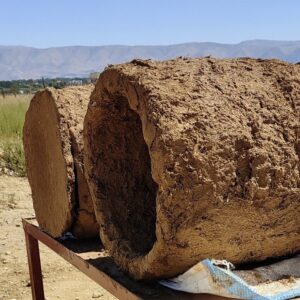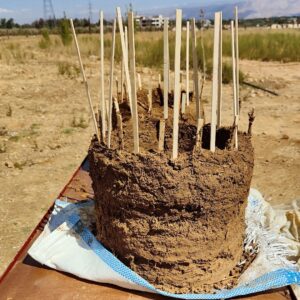Reviving the rammed-earth hives
Conserving the path through conserving the past
For half a century now, all the traditional methods of beekeeping in Lebanon have been abandoned, due to the competition of productive agronomic methods.[1] In Lebanon, no sample of rammed-earth hive, ceramic hive, or hive plaited with reed can be found. Only seniors can tell us about these old methods, but their memories are in danger of disappearing when they leave us.
To protect this knowledge, A Rocha Lebanon decided to list the ancient types of beehives and to learn how to build them in order to create a conservatory apiary. Three different types have already been identified and the process organized. In September, thanks to Adnan from Taanayel farms, we built two samples of rammed-earth hives. (See the recipe below.)
But why should we bother conserving old methods if new ones are more efficient?
Indeed, on one hand, those industrial methods have their own weaknesses, and on the other hand, they are possible and efficient only under certain economic circumstances. Yet economic circumstances change…Therefore, conserving the past is conserving the paths.
Lebanese beekeepers exclusively use the Langstroth beehive, and no comparison can be done anymore with the other types. Containing ten frames on every level, the Langstroth beehive can welcome big swarms in a narrow space, which requires a lot of work from the bees to be cooled during hot summer days. Rammed-earth walls keep the cool and do not require any effort from the bees. However, the main issue in the Lebanese context is the high dependence of those beehives on market: wood and wax are imported, and the collapse of the currency made it very expensive. Building rammed-earth beehive only uses local materials, and the bees build the honeycombs with their own wax.
Yes, the rammed-earth beehive has a lot of defaults: it is not waterproof, it is breakable, it is not transportable, and the honeycombs are quite little and cannot be reused. Even so, it shows other possibilities than framing and waxing and thus frees beekeepers from their dependency on the global market. Progress can be also made to the rammed-earth model to develop another technique other than wooden hives.

Recipe for the rammed-earth hive
Equipment: wheelbarrow, sieve, plastic sheet, bucket
Ingredients: clay soil, straw, wooden sticks
Time: two weeks during the summertime
Step1. Preparation of the clay
Screen the dirt with a fine sieve, cut the straw, melt the clay with the straw (2/3 of clay, 1/3 of straw), water the mix, and let it sit covered with a plastic sheet under the sun.

Step 2. Construction of the first level
After three sunny days, you can begin the shaping. Make a circle of 5 cm high that is 5 cm larger than the bucket, then place the bucket in the center and build a wall that is 10 cm high. Plant the wooden sticks in the wall and remove the bucket.

Step 3. Every following day, raise the wall 10 cm higher, using the bucket to keep the same size.

Step 4. Build the cover side, making a circle of clay with a star of wooden sticks inside.

Step 5. Line the inside of the hive with a layer of clay without straw.
Step 6. Lay the hive and place the cover. Dig on both sides a door for the bees.
It is ready! The rammed-earth hive must always be kept away from rain and humidity, so raise it from the floor and cover it with a roof.
The harvest of the honey will be done from both sides, by opening the cover and sawing the back.
[1] For some details on this change in Syria, see Thierry Boissière, Le jardinier et le citadin, Damas: Presses de l’Ifpo, 2005, p. 292–3.